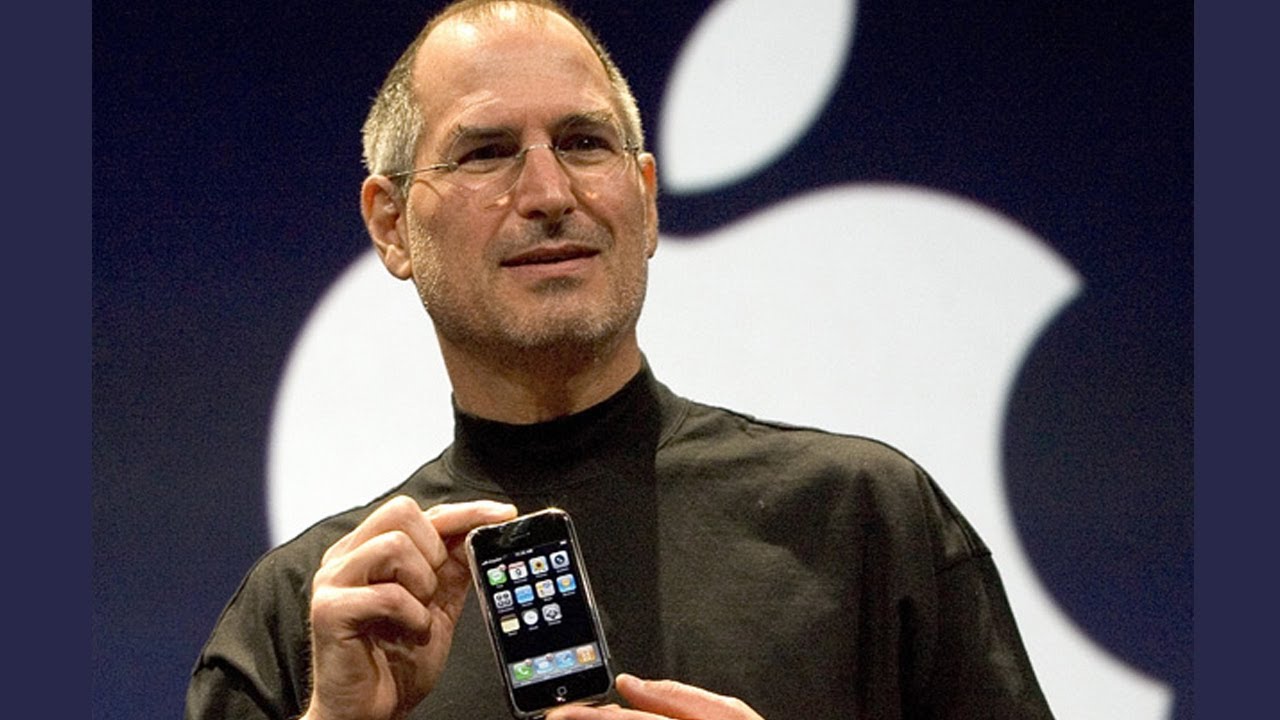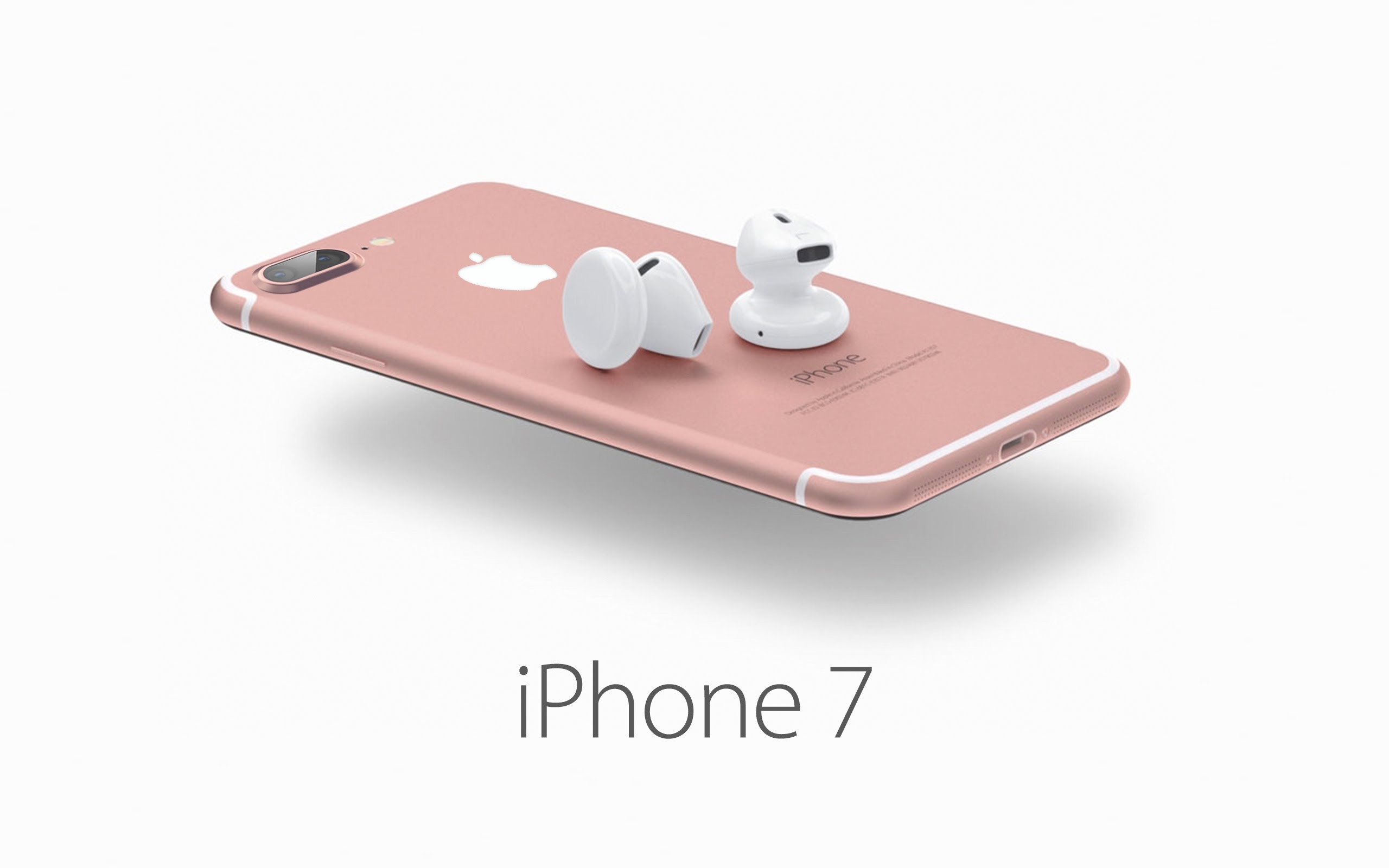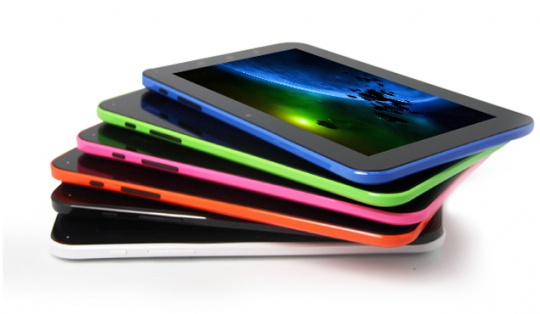The iPhone is the Most Influential Gadget of All Time: A Closer Look at the iPhone Legacy
by September 12, 2016 7,507 views5
At the recent Apple Special Event, the latest iterations of the iPhone – the iPhone 7 and the iPhone 7 Plus – were launched alongside the Apple Watch Series 2. As it turns out, most of the leaked specs and rumours about the new iPhone models were accurate. Both models incorporate some neat features – a more powerful A10 Fusion chip, a better camera unit, and improved internal storage.
Many seemed to have expected more from the newest iPhone models. Nonetheless, the iPhone brand has come a long way over the last nine years from the time the original iPhone was first introduced. Let us go back in time when Apple forayed into the smartphone space and went on to become the juggernaut that it is today.
The Original iPhone – How It All Began
Every once in a while, a revolutionary product comes along that changes everything.
These were the memorable words spoken by the legendary Steve Jobs almost a decade ago at the Macworld Conference and Expo held in San Francisco. At the convention, the late, charismatic co-founder of Apple went on to proclaim that Apple was going to reinvent the phone and, as the cliché goes, the rest is history.
The world watched in awe as Jobs unveiled Apple’s first touchscreen mobile phone, which seamlessly combined the features of an iPod with touch controls and a cutting-edge Internet communications device. The primary goal was to offer a smartphone that was genuinely “smart” and easy to use. The day was January 9, 2007, when Apple gave the world – the iPhone.
Upon deep diving into the history of the touchscreen tech, you will learn that way back in 1992, IBM Simon was actually the first mobile phone to have a touchscreen. However, Apple is the company that truly innovated touchscreen technology with the iPhone. The iPhone had a user interface with patented multi-touch technology. This revolutionary interface was unlike that of its popular counterparts at the time – the Motorola Q, BlackBerry, Palm Treo, and Nokia E62 – which came with physical keyboards.
The iPhone ran on OS X, which gave it desktop-class applications and networking functions that were way beyond the capabilities of any other phone at the time. The phone was indeed way ahead of its time with the incorporation of a proximity sensor, ambient light sensor, and accelerometer. The iPhone had, thus, effectively ushered in an era of thin, touchscreen smartphones with powerful software and incredible applications.
The App Store – Advent of the Mobile Software Revolution
In 2008, along with the second iteration of the original iPhone – the iPhone 3G – the App Store was made available with more than 500 native applications.
“Nothing like the App Store existed before, and it has fundamentally changed the world,”
– Tim Cook, current CEO, Apple Inc.
The introduction of the App Store paved the way for the development of convenient and powerful mobile applications as we know them today. The emergence of these apps not only changed the way people communicated and made transactions but also sprung up billion-dollar companies and created millions of job opportunities. Check out more details and some incredible stats here. It is, therefore, no surprise that Time Magazine named the iPhone the most influential gadget of all time.
iPhone Market Performance – Remarkable Sales Figures
The iPhone is reportedly the best-selling gadget of all time. In January 2015, Apple reported the best quarter in corporate history, wherein iPhone sales accounted for 68% of the company’s net revenue. Apple sold more than 74 million iPhone units in the first quarter of 2015, which is about 34,000 iPhone units every hour. Tim Cook credited this incredible market performance to the buzz surrounding the iPhone 6.
In the second quarter of 2015, the iPhone generated a revenue of a whopping $40 billion. To put this in perspective, the figure is 167% higher than the total revenue of the entire global recorded music industry in 2014. For some more interesting stats pertaining to Apple products, check out our iPhone infographic.
Fast forward to the present, Apple is one of the world’s top ten public companies with a net worth of $586 billion (source: Forbes). According to Strategy Analytics, a market research firm, the iPhone 6s was the best-selling smartphone followed by the iPhone 6 and the Samsung Galaxy S7 Edge in the second quarter of 2016.
“We estimate the Apple iPhone 6s model shipped 14.2 million units and accounted for 4 percent share of all smartphones shipped worldwide in Q2 2016. Apple’s iPhone 6s is currently the world’s most popular smartphone. The iPhone 6s is wildly popular in dozens of countries globally, due to its attractive hardware design blended with rich features such as 4K video, large multi-touch display, and fingerprint security.”
– Neil Mawston, Executive Director, Strategy Analytics.
According to Woody Oh, Director at Strategy Analytics, the iPhone 6 shipped 8.5 million units worldwide, placing it in second position with a 2% market share in Q2 2016. He goes on to add that even after 2 years of launch the iPhone 6 has managed to remain in the best-seller lists across Europe and other regions.
Shrinking Market Share – Cause for Concern
The iPhone 6s and the iPhone 6 may be the best-selling smartphone models as of today. However, the iPhone share seems to be dipping with the growth of the global smartphone market. According to Gartner, more than 344 million smartphone units were sold in the second quarter of 2016, which is an increase of 4.3% over the second quarter of 2015.
Table 1: Worldwide Smartphone Sales By Vendor (Thousands of Units)
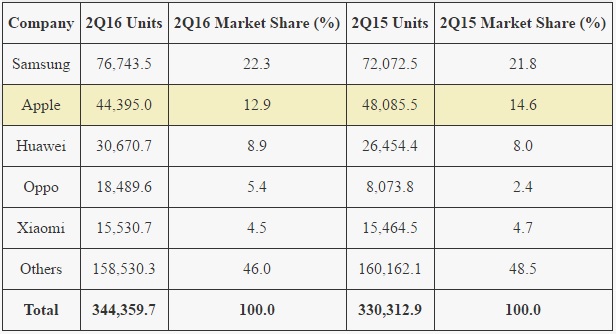
Companies like Huawei and Oppo have been expanding at a rapid pace. The growth of these companies and several other factors led to the decrease of the iPhone share to 12.9% in the second quarter of 2016 from 14.6% in the second quarter of 2015. The drop in sales resulted in a decline in the share of iOS as well. On the other hand, the share of Android has been growing so quickly that we could very well be headed towards an Android monopoly.
Table 2: Worldwide Smartphone Sales By Operating System (Thousands of Units)
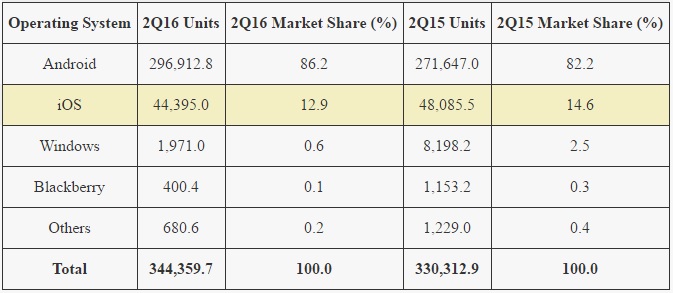
iPhone 8 – A Potential Game Changer
The iPhone 7 and the iPhone 7 Plus come with several improvements. However, they do not seem to be a significant upgrade when compared with their predecessors – the iPhone 6s and the iPhone 6s Plus. Although reports suggest that the latest iterations will be sold out quickly, Apple is expected to really turn things around next year when it launches the iPhone 8.
The iPhone 8 is likely to give loyal Apple fans and tech enthusiasts what they have really been waiting for: a radical redesign, a larger battery, the wireless/fast charging feature, and **drum rolls** an OLED display with improved resolution and pixel density. Rumours also suggest that the iPhone 8 will be powered by a 10-nanometer A11 chip and have an all-glass and aluminium design. In addition, it will likely have features such as an iris scanner and a Touch ID embedded into the display.
Although Samsung currently reigns supreme in the global smartphone market by far, the recent recalls of all the Samsung Galaxy Note 7 units are likely to hurt its sales. And Samsung’s loss could very well be Apple’s gain. However, in order to propel its market share, Apple will need to produce something truly special in the iPhone 8 with the incorporation of the aforesaid features or even more.
